Shadowing an Eco-Couture floral designer
February 5th, 2012
Bess Wyrick, Celadon & Celery
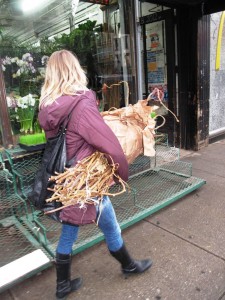
- Bess, on an early-morning visit to the NYC floral district, carrying an armload of kiwi vines for her next arrangement.
I planned on being in New York for a few days last month so I called Bess Wyrick of Celadon & Celery to see if we could get together. David Perry and I met Bess in person last November when we flew to Los Angeles to produce a story about Bess’s DIY floral design workshops. I had previously interviewed her by telephone – for a piece in the Los Angeles Times. In April, when The 50 Mile Bouquet comes out, you will be able to read all about Bess and her eco-couture floral design tips and techniques.
“Why don’t you come with me to one of my client’s?” Bess suggested. I met her in New York’s Chelsea Flower District at 7:30 a.m. one morning and we headed to her regular source for flowering branches.
Ironically, I had visited the same vendor on a trip to NYC two years ago. On this shopping trip, Bess picked out a huge bunch of kiwi vine, with nutmeg-colored bark and attractive curls. The kiwi is locally harvested and cut to 4- and 5-foot lengths.
We headed up to midtown to a restaurant called Rouge Tomate, a 2-star Michelin establishment known for its modern, organic fare. Celadon & Celery is responsible for designing weekly arrangements for the hostess station, the main dining room and the downstairs private dining room. Because of the restaurant’s organic menu and reputation for serving local ingredients, it makes sense that the owners of Rouge Tomate want their flowers to echo similar values.
The restaurant’s credo: “At Rouge Tomate, we give preference to local and seasonal products, including fruit and vegetables grown on farms that respect the environment; choose fish depending on their stock and impact on ecosystems; select meat and poultry from farmers that feed their animals with local plants; highlight quality wines grown by viticulturists who follow organic or biodynamic principles.”
From a floral designer’s point of view, it’s easy to adhere to these principles when summer’s abundance offers more choices than you can ask for. Come January, though, Bess gets creative. And I was eager to see how her commitment to seasonal and local played out first hand.
Before I arrived, Bess’s driver had delivered the other flowers she needed. Those ingredients included the longest and most slender gladiolas I had ever seen. In pale green, the blooms were clearly hothouse grown, but they weren’t imported. Along with the glads, Bess had requested yummy bunches of winter anemones in the deepest plum hue, with dark black centers. She also sourced quirky purple artichokes on stems. All of these ingredients came from greenhouses in Florida, whereas the kiwi and pussy willow branches came from local farms on Long Island.
Bess’s arrangement for the main dining room was simple yet completely sophisticated. She first filled a tall, square container with the kiwi branches, using them to create a tree-like structure that soared above dining tables. Bess arranged the glads in and among the kiwi, using that fresh promise of spring green against the earthy kiwi bark to make a thoroughly organic statement.
Downstairs, Bess filled two matching vases with a similar version of the upstairs combo. The pair of vases flanks either side of a staircase that descends to the private dining room. These containers were large enough to accommodate an addition of pussy willow branches in and among the kiwi vines and green glads.
Finally, the hostess stand called for an impactful, smaller-scale design. Bess filled two bark-wrapped cylinder vases with what, to me, is a dazzling duo in purple: Artichokes and Anemones. I love the vegetable-and-flower pairing. It’s especially fitting for a restaurant venue, and it works nicely because of the purple palette. A few curly kiwi vines emerge from this design, helping to connect the smaller vases with the ingredients of the larger ones.
After finishing her design work, Bess still had cleanup duties. She brings biodegradable garbage bags with her when she designs on location. All the cuttings and trimmings get tossed in the giant bags, which are then placed with the restaurant’s kitchen compost. Any cardboard goes into the recycling, leaving zero waste on site.
This weekly ritual is one that keeps Bess in close contact with the restaurant management and kitchen staff. As a result, when weddings and private events are booked into Rouge Tomate, it’s a given that Celadon & Celery is called in to design eco-friendly flowers for the clients.









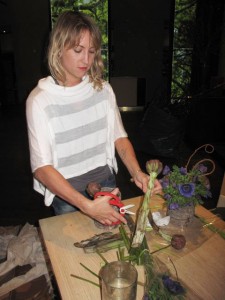
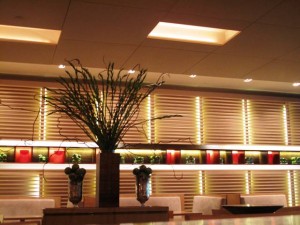
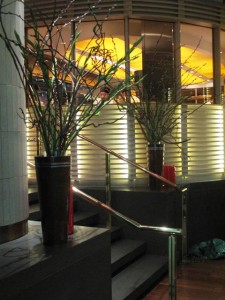
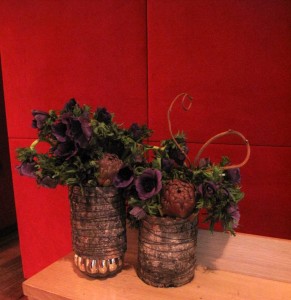
February 7th, 2012 at 6:59 am
Growing up on a farm, I can definitely say Organically-farmed food is much better than the processed stuff. I live in the city now and oh how I miss my organic farm. I will have to visit this restaurant sometime to get some of the, I’m sure, tasty food they serve. It is so amazing that Bess uses biodegradable garbage bags. Thanks for helping our environment one little step at a time.
February 7th, 2012 at 4:44 pm
Artichokes in a floral arrangement!? I love it! And using local and eco friendly products is a very admirable way of doing business- great read!
February 13th, 2012 at 11:42 am
I enjoyed this so much. Thank you also for the wonderful dinner at your home. It was great to meet at least part of your beautiful family, and I love your new house.~~Dee
February 16th, 2012 at 11:28 pm
The BEST thing about Sunset magazine this month was the preview on your upcoming book.
I love to use kumquats in arrangements this time of year.